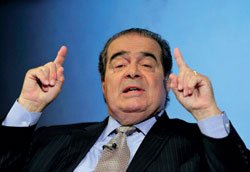Supreme Court justices regularly seek to change the errors of their ways

Justice Scalia, responding in his dissent to
Justice Kagan’s point, inadvertently changeda name from “Jane” to “Jill.” Reuters/Brendan
McDermid
Late in the recently completed Supreme Court term, Justice Antonin Scalia dissented in a little-noticed case about a federal bank fraud law.
In Loughrin v. United States, the court held that the government did not have to prove that a defendant intended to defraud a financial institution to violate the statute. In the majority opinion, Justice Elena Kagan was making a point about financial transactions when she referred to a hypothetical “Jane,” who “traded in her car for money to take a bike trip cross-country.”
Justice Scalia, responding in his dissent to Justice Kagan’s point, inadvertently changed the name to “Jill.”
By the next day, the Supreme Court had revised the electronic slip opinion in the case, changing Scalia’s references from Jill to Jane.
It was an inconsequential change, but one of a type that occurs far more frequently in Supreme Court opinions than most people realize, according to a new study.
“The court makes all sorts of revisions, ranging from the most mundane to the most intriguing, with the vast majority not surprisingly falling into the former category,” writes Harvard Law School professor Richard J. Lazarus in “The (Non)Finality of Supreme Court Opinions,” an upcoming article for the Harvard Law Review. “With regard to the latter, several distinct pathways have emerged for revising opinions with varying degrees of transparency.”
Two more examples from this past court term help illustrate the kinds of after-the-fact changes made to the court’s opinions.
In her May 5 dissent in Town of Greece v. Galloway, in which the court upheld a New York state hamlet’s practice of opening its council meetings with prayer, Kagan discussed the message of religious tolerance that George Washington received in a 1790 visit to Newport, Rhode Island, which Kagan described as “the home of the first community of American Jews.”
The court, after being apprised by scholars that Newport was not, in fact, the first such community, changed Kagan’s dissent (presumably at her instigation or with her approval) to “home of one of the first communities of American Jews.”
A few days earlier, in his dissent in Environmental Protection Agency v. EME Homer City Generation, Scalia had mischaracterized an EPA legal argument from an earlier Supreme Court case. Several law professors and other court observers noticed the mistake and took to the Web. Within days, the dissent was quietly amended, including a change in a subheading over one section from the colorful “Plus ça Change: EPA’s Continuing Quest for Cost-Benefit Authority,” to the bland “Our Precedent.”
Lazarus says he had completed his 85-page article about a year ago, and it was being edited for publication in the Harvard Law Review’s December 2014 edition when the EME Homer City Generation correction was made. “I realized I had to do more,” he says. He released the study in draft form, which prompted a spate of media and scholarly attention.
Click here to read the rest of “Writing Their Wrongs” from the August issue of the ABA Journal.



